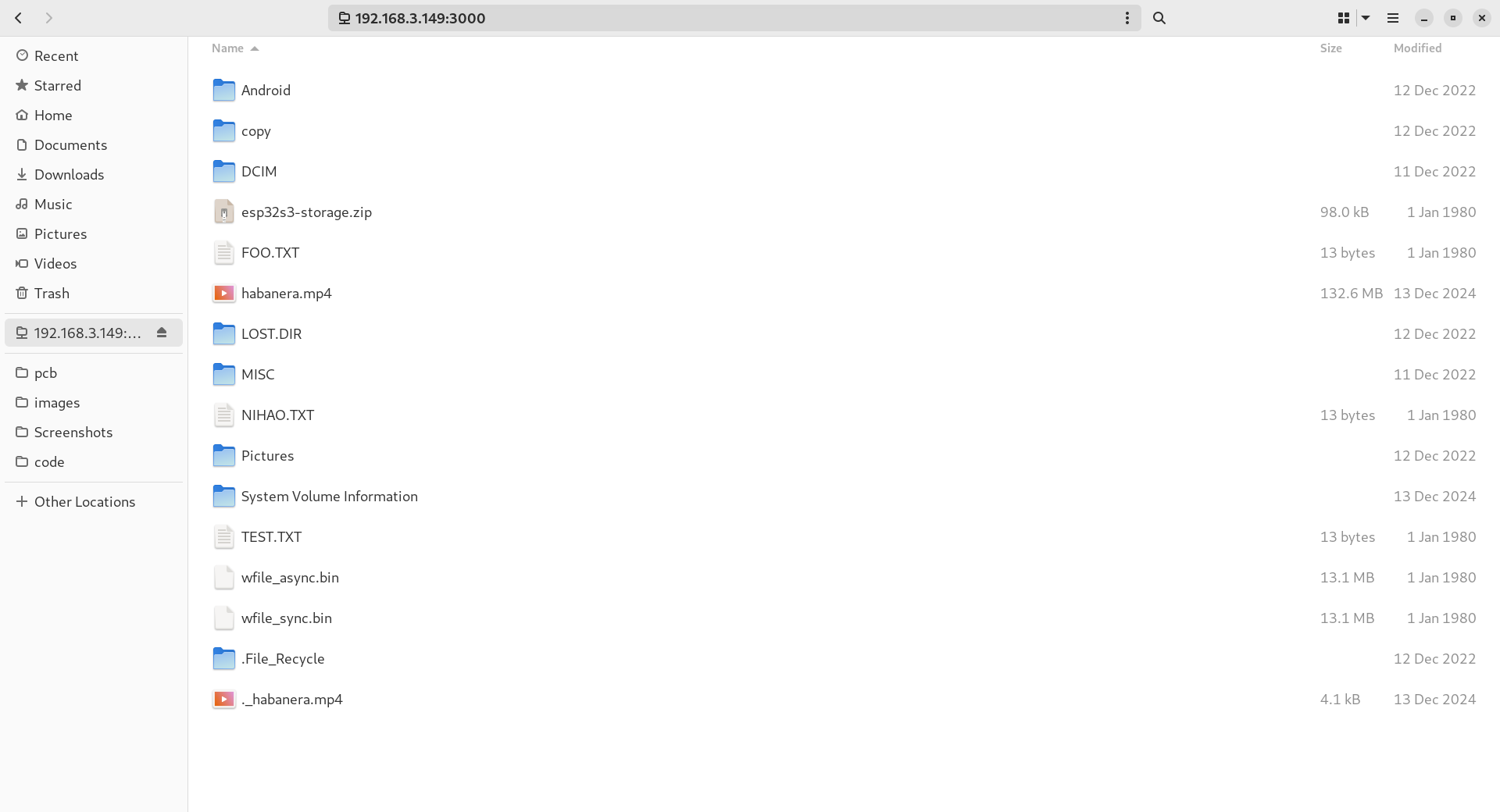一种基于ESP32丰富连接能力的移动存储设备 – 测试TF读写速度
前言
在前面的文章中我已经验证了TF卡读写功能,证实了我们可以通过ESP-IDF的接口访问FAT格式的TF卡。为了验证通过WebDAV协议访问TF卡的体验,我将WebDAV前端和TF卡访问功能集成到了一起,使得WebDAV模块可以从TF卡挂载的位置读取文件。本文是我的测试过程。
本系列其他文章
- 一种基于ESP32丰富连接能力的的移动存储设备
- 一种基于esp32丰富连接能力的移动存储设备 – 电路设计
- 一种基于esp32丰富连接能力的移动存储设备 – 测试sd卡读写
- 一种基于esp32丰富连接能力的移动存储设备 – 验证屏幕显示
测试micro-storage
本文使用的代码都可以在代码仓库esp-webdav中找到,在微型存储上运行程序后,我们可以在电脑上通过webdav服务查看tf卡上的数据。

测试顺序读取速度
我们希望测得TF卡的顺序读取速度,因为通过WebDAV协议访问基本上不会有随机读取的场景,测试顺序读取速度应该就够了。为了测试无干扰下的TF卡顺序读取速度,我写了一个顺序读取一个大文件的函数。
async fn test_file_perf(mount_point: &str) -> anyhow::Result<()> {
let file_path = format!("{}/habanera.mp4", mount_point);
tokio::task::spawn(async move {
let mut file = tokio::fs::File::open(file_path).await?;
let mut read_buf = std::vec![0;32*1024];
let mut read_size: usize = 0;
let beg = tokio::time::Instant::now();
for _i in 0..400 {
let size = file.read(&mut read_buf).await?;
read_size += size;
}
info!("[Async] Read {} bytes in {:?}", read_size, beg.elapsed());
Ok::<_, anyhow::Error>(())
}).await?
}
fn test_file_sync(mount_point: &str) -> anyhow::Result<()> {
let file_path = format!("{}/habanera.mp4", mount_point);
let mut file = std::fs::File::open(file_path)?;
let mut read_buf = std::vec![0;32*1024];
let mut read_size: usize = 0;
let beg = tokio::time::Instant::now();
use std::io::Read;
for _i in 0..400 {
let size = file.read(&mut read_buf).unwrap();
read_size += size;
}
info!("[Sync] Read {} bytes in {:?}", read_size, beg.elapsed());
Ok::<_, anyhow::Error>(())
}
用于测试的文件位于TF根目录下,大约有100MB。测试方法很简单,每次读取32KB的文件内容,连续请求400次,最后获取消耗的时间。
I (1709) micro_storage: [Sync] Read 13107200 bytes in 1.593215s
...
I (21727) micro_storage: [Async] Read 13107200 bytes in 4.229245s
我共测试了两次,第一次使用同步接口,第二次使用了tokio库的异步接口。使用异步接口后同样的任务时间却增加了2.6秒,大概由于只有一个并发请求,增加了开销但没有带来收益。但增加的时延具体耗费在哪些事情上了,还需要进一步分析。对于ESP32这样的资源受限的平台,使用异步编程接口可能是”杀鸡用了牛刀“。同步读的速度约为7.9MB/秒,异步读的速度约为3.0MB/秒。
测试顺序写速度
测试顺序写速度使用了和测试顺序读类似的方法。而且也测试了一次同步接口和一次异步接口。
async fn test_wfile_perf(mount_point: &str) -> anyhow::Result<()> {
let file_path = format!("{}/wfile_async.bin", mount_point);
tokio::task::spawn(async move {
let mut file = tokio::fs::File::create(file_path).await?;
let mut write_buf = std::vec![0xfu8;32*1024];
let mut write_size: usize = 0;
let beg = tokio::time::Instant::now();
for _i in 0..400 {
let size = file.write(&mut write_buf).await?;
write_size += size;
}
info!("[Async] Write {} bytes in {:?}", write_size, beg.elapsed());
Ok::<_, anyhow::Error>(())
}).await?
}
fn test_wfile_sync(mount_point: &str) -> anyhow::Result<()> {
let file_path = format!("{}/wfile_sync.bin", mount_point);
let mut file = std::fs::File::create(file_path)?;
let mut write_buf = std::vec![3u8;32*1024];
let mut write_size: usize = 0;
let beg = tokio::time::Instant::now();
use std::io::Write;
for _i in 0..400 {
let size = file.write(&mut write_buf).unwrap();
write_size += size;
}
info!("[Sync] Write {} bytes in {:?}", write_size, beg.elapsed());
Ok::<_, anyhow::Error>(())
}
测试结果如下。经过计算同步写的速度大约为3MB/秒,而异步写速度只有1.8MB/秒。
I (6263) micro_storage: [Sync] Write 13107200 bytes in 4.11604s
...
I (29223) micro_storage: [Async] Write 13107200 bytes in 7.079895s
总结
我们得到同步顺序读写的速度为7.9MB/秒和3MB/秒,异步接口的顺序读写性能要差一些,为3MB/秒和1.8MB/秒。前一对数字还差强人意,后一对数字就有点难看了。但是我们的WebDAV程序正是使用的异步接口,所以读写性能不会太好。本来想实际测试WebDAV程序的下载和上传性能,但是因为系统经常报告内存不够,导致系统OOM。虽然我的ESP32S3模块有8MB的SPIRAM,但是我发现启用了SPIRAM之后,会出现无法挂载TF卡的错误,我怀疑是硬件设计的问题,还需要等优化了SDMMC硬件后再次测试。
链接
- esp_webdav - https://github.com/paul356/esp-webdav